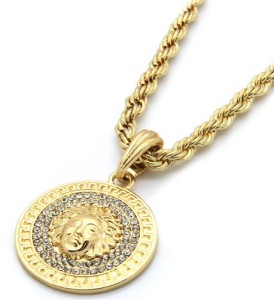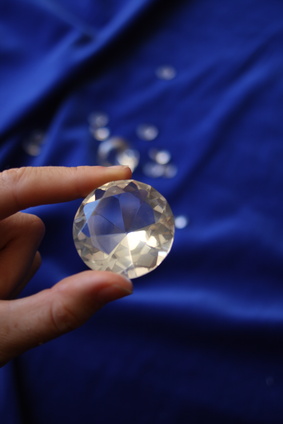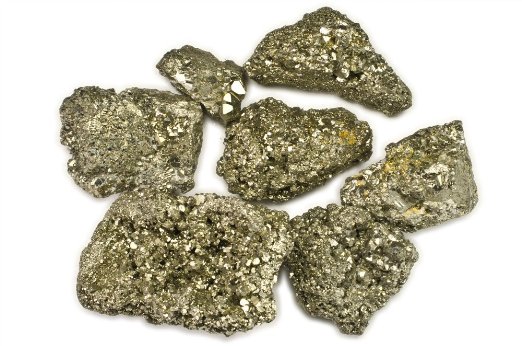Real gold jewelry is made of a solid gold alloy, whose gold content is above a certain threshold. In the United States, for example, pieces containing less than 58.3% gold (10 karats) are not considered gold for commercial purposes.
What people usually refer to as fake gold is jewelry that is made of another metal (such as nickel, copper, silver, etc.) and covered with a layer of gold (gold plated) or with a thin gold sheet (gold filled).
How to Tell If Gold Is Real
Below are some of the more reliable ways to test jewelry for gold:
Acid Test
Testing gold with nitric acid is a pretty reliable way to tell how pure a gold alloy is.
The piece being tested is scratched against a testing slab so as to leave a scratch mark on it. Then, nitric acid of varying concentrations is applied to the mark to see whether it will be dissolved. Depending on the concentration of the acid that causes the mark to be dissolved, the purity of the alloy can be inferred.
This test can be performed at the jewelry store by a jeweler or at home, by using a gold testing kit and following the instructions that come with it.
You should keep in mind that the scratch should be deep enough so that you can get to the material beyond the top layer of the jewelry.
Otherwise, if the piece is gold plated or gold filled, a light scratch might only rub off the top gold layer, and the test will show that what you have is indeed gold.
Gold Markings
Karat markings on jewelry indicate its purity. For example, a “10K” mark means that the jewelry is 10 karats, meaning that in every 24 parts alloy there are 10 parts gold.
European jewelry is often marked with parts-per-thousand markings instead of karat hallmarks. For example, if you see a mark that reads “417”, this corresponds to 10 karats, which in turn corresponds to 41.7% purity (10 divided by 24).
It is important to look for any markings next to the karat or purity number that might indicate that the jewelry is gold plated or gold filled.
Letters such as GP (gold plated), GF (gold filled), RGP (rolled gold plate), HGE (heavy gold electroplate), or GEP (gold electroplate) all mean that the piece is not made of solid gold.
Markings are not necessarily reliable, though. Fake gold that is just plated could be missing any letters identifying it as such..
Scratches and Discoloration
If a jewelry piece is gold plated or gold filled, a deep enough scratch would reveal the metal beneath the gold surface.
So, if you see any scratches under which the metal below is visible or discolored spots where the top layer has been rubbed off, this is a sign that the jewelry is just covered with gold and note made entirely of it.
Gold Color and Karats
An indication that a piece of jewelry might be gold plated is if its color is the intense yellow that is characteristic of pure gold. Gold-plated items are sometimes covered with a layer of 24-karat gold.
In contrast, pieces made of solid gold don’t usually have the same color, as 24K gold is not used to make jewelry because of the softness of the metal.
Other Methods to Detect Fake Gold
The methods listed below are of limited usefulness, as they are more unreliable than the tests described above.
Bite Test
This is a popular test that is based on the fact that gold is soft, so if you bite it, your teeth should leave marks on it.
However, the bite test is not a good method to check if a gold piece is real.
First, lower-karat gold alloys (such as 10K or 14K gold) are relatively hard because of the higher content of non-gold metals in it, and these alloys would not pass this test despite being considered real gold.
Second, there are other soft metals that can pass the bite test and that can be covered with gold to make a fake gold piece.
Magnet Test
The magnet test is another popular test. The reasoning behind it that fake gold should be attracted by a magnet while real gold should not.
It is true that pure gold is not magnetic. However, there are a number of other metals that are also not magnetic and that can be used to make a gold-plated jewelry piece.
Moreover, real gold jewelry can contain magnetic metals as part of the gold alloy used to make it.
Density Test
This test is more sophisticated than the other two mentioned above. It works by dropping the item in a tank filled with water and measuring how much water it displaces.
Based on the ratio of the weight of the piece to the amount of water it has displaced, you can calculate its density and infer how much gold it contains.
The problem with this test (apart from requiring precise measurement and more complex calculations) is that it is very hard to come up with a reliable benchmark as to how dense an alloy of a certain karat should be.
For example, what should be the density of 14K gold? Different vendors could add non-gold metals in different proportions in a 14K alloy, and therefore its density can vary widely.
To make matters worse, because of this potential variation, the density of a gold-plated piece could happen to be close to the density of a real solid gold piece.
How to Spot a Fake Gold Chain
Fake gold chains are not made of solid gold and are often simply gold plated. Gold-filled chains can also be passed off as pieces made of solid gold.
Similar to gold-plated items, these chains are also made of non-gold metals, but instead of plated with gold, they are wrapped in a thin sheet of it, which is attached to the core metal under high temperature.
Gold Chain Hallmarks
Look at the chain and see if you can find any markings stamped on it. If you find numbers followed by the letters K, KT, or KP, this is an indication of the karat of the piece, and it is likely that it is made of solid gold. European gold markings are often expressed in terms of decimals. For example, a stamp that reads 583 or 585 corresponds to a gold purity of 14 karats, which denotes a gold percentage of 58.3%.
In contrast to solid gold pieces, gold-plated and gold-filled chains usually have a few additional letters after the karat/purity mark. Gold-plated and gold-filled chains are often marked with stamps such as GP, GEP, RGP, HGE, HGP, or GF. For example, a chain with a marking “14K GP” is actually gold plated, and the karat number denotes the purity of the plating, not of the whole piece.
Note: Even if a gold chain is stamped with a karat number without any additional letters, this does not guarantee that the piece is solid gold. There are all kinds of jewelry vendors, and not all sell items that are properly marked.
Testing a Gold Chain
Testing jewelry with nitric acid is one of the most reliable ways to find out how much gold it contains. You can take your gold chain to a jeweler for a test. Acid testing can also be performed at home with a gold testing kit.
Gold Chain Color
Ironically, a chain whose color is as yellow as that of pure gold is unlikely to be made of it. This is because gold-plated and gold-filled jewelry is often covered with 24-karat gold, which is too soft to be used to make an entire piece. And if the piece has a 24K mark but the price is too low for such a high purity, it is very likely that you’re dealing with a gold-plated or gold-filled piece.
An even stronger indication that a gold chain may be fake is any sign of discoloration on it. When a gold-plated or gold-filled item is scratched, you should be able to see the metallic color of its non-gold core.
Where to Buy Real Gold?
For jewelry with diamonds, emeralds, rubies, or sapphires, we recommend James Allen (read review) because you can take a 360-degree look at any stone before having it set in gold.
















